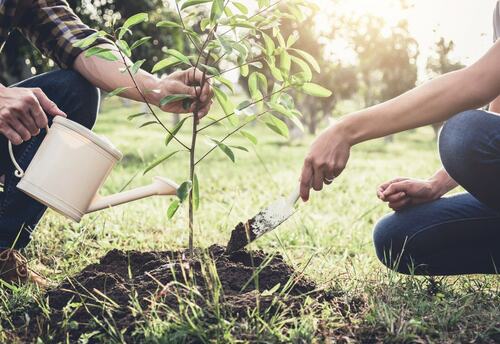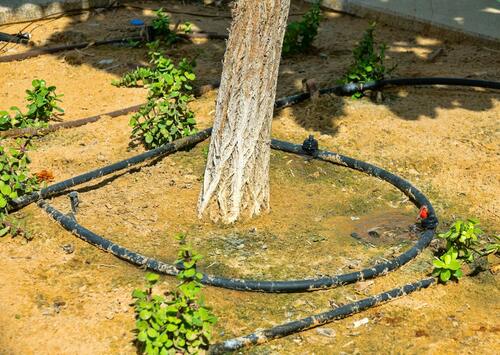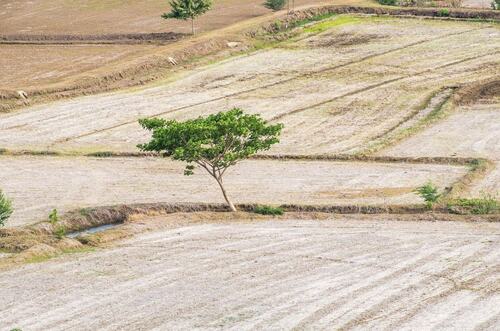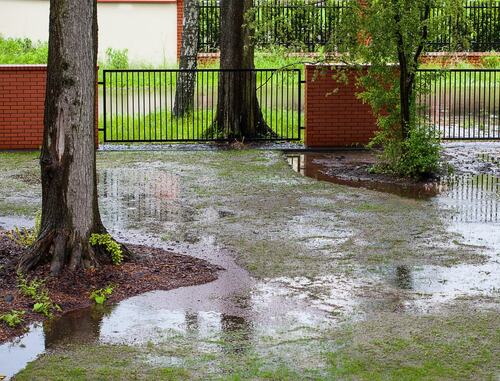How Much Should I Water My Tree?
Introduction
Finding the right amount of water your tree needs involves looking at many different factors. These factors include the tree’s age, species, soil type, climate, and the season. Here are some general guidelines to help you determine how much to water your tree :
Newly Planted Trees (First 1-3 years)

A Young Tree Needs More Frequent Watering
Trees that have just been planted need to be watered more often than trees that have already been established. This is because the roots of the newly planted tree aren’t fully developed. Giving your tree the right amount of water is really important for the first few years to make sure it can grow a strong root system.
FREQUENCY
Newly planted trees require more hydration than older trees. Generally, it is best to water them two to three times a week for the first few months. After the first few months, you can reduce it to once a week. Keep in mind the weather conditions when watering and adjust accordingly. When it is really hot or there is a drought, you may need to water your tree more often to make sure it gets enough.
AMOUNT
Ensure the soil is moist but not waterlogged. Use about five to fifteen gallons of water per week depending on the size of the tree and weather conditions. For small trees, five gallons per week may be sufficient, while larger trees may require up to fifteen gallons.
METHOD
Deeply watering your tree can encourage deeper root growth. This can be done by using watering tools like a soaker hose or drip irrigation. These kinds of tools release water into the soil slowly, allowing it to reach the deeper roots. This helps the tree to grow healthier and stronger. Don’t use sprinklers to do this, however. This is because the water will not reach the deeper roots and it will instead lead to water runoff and inefficient watering.
Established Trees

Drip Irrigation Ensures Deep Watering for Mature Trees
Once trees have been growing long enough in one place to have new growth and roots, they don’t need as much water as they did before. This is because established trees have larger roots and can reach deeper moisture in the soil that new trees cannot. However, they still do need regular watering, especially during dry spells.
FREQUENCY
Established trees do not have to be watered as often as newly planted trees. However, they must be watered more deeply so that the water can reach the tree’s larger root system. Generally, these trees should be watered once every two to four weeks depending on the species and climate. You should adjust how much you water your tree according to weather conditions, however. During long dry spells , you may need to water your tree more often so that your tree’s roots can get the amount of water they need.
AMOUNT
When you water your tree, you should make sure the water reaches between twelve and eighteen inches into the soil. The best way to make sure your tree gets the right amount of moisture is to use enough water to soak the root zone thoroughly. You may need to use several gallons of water to do this depending on the size of the tree and the soil conditions.
METHOD
Water the area under your tree’s canopy, or the layer of branches and leaves that cover the ground when looking down from the top of it. This area below the tree is called the drip line and is where the tree’s most important roots lie beneath the soil. This can be done using a soaker hose, drip irrigation , or other deep-root-watering tools as mentioned before. These methods of watering the drip line and slightly beyond it make sure that water reaches the entire root zone. Doing this will make sure your tree will grow healthy and make sure the roots grow deeper rather than staying right below the surface.
Factors Influencing Water Needs

A Tree Thrives in an Arid Landscape with Minimal Watering
There are many factors that influence how much water a tree needs. Understanding these factors can help you make sure you have the right water schedule for your tree, keeping it healthy and helping it grow.
TREE SPECIES:
Species of trees that can handle droughts , such as oak or pine trees, don’t need to be watered as often. This is because these species are already adapted to dry conditions, so they can survive with smaller amounts of water. Other species of trees that love water, like willows or maples, will need to be watered more often. This is because they need more moisture to survive.
SOIL TYPE:
There are many different kinds of soils used for growing trees; however, your tree may need a certain type of soil to grow best. Sandy soils usually drain quickly and may need to be watered more often. This is because sand does not hold moisture well, so trees planted in this type of soil will need to be watered more often so that they can absorb the moisture they need. Clay soil holds water longer but can also become waterlogged if you are not careful. Because of this, trees planted in clay soil may not need to be watered as much but will need to be watched to make sure the soil around them doesn’t get waterlogged.
CLIMATE AND WEATHER:
Hot, dry climates or periods of drought will increase how much water your tree will need to survive. Trees growing in these conditions will need to be watered more often in order to compensate for the lack of natural rainfall. Cooler, more rainy climates or climates with seasons make it so that you don’t have to water your tree as often. This is due to the fact that these climates naturally have more rain than drier climates.
Signs of Overwatering and Underwatering

Overwatering May Harm the Health of These Backyard Trees
The amount of water your tree gets is very important to its health. Both overwatering and underwatering your tree can hurt its health. This is why it’s important to be able to recognize the signs your tree isn’t getting the right amount of water—so that you can adjust how you water your tree.
OVERWATERING
If your tree is being overwatered, then the soil around it may appear soggy. The leaves will also often turn yellow and drop. Overwatering can lead to roots rotting as well as other issues. This is why it’s important to make sure the soil around your tree is well drained and not waterlogged.
UNDERWATERING
If your tree is being underwatered, then the soil around it will appear to be dry. The leaves of your tree will appear brown and wilted. Underwatering can stress out the tree, making it more susceptible to pests and diseases. The best way to make sure your tree isn’t being underwatered is to make sure the soil is moist, not dry.
ADDITIONAL TIPS FOR EFFECTIVE WATERING
- Mulching: Applying a 2–4 inch layer of mulch around the base of the tree will help keep the moisture around your tree and lessen the amount of evaporation. Mulch also helps regulate the temperature of the soil and prevents weeds from growing around the tree.
- Morning Watering: Watering in the morning can lessen the amount of water that evaporates during the day. This allows the tree to absorb water throughout the day and protects it from the heat of the day.
- Avoid Trunk: Do not water your tree directly at the base of the trunk. Rather, water around the drip line instead. This will encourage the roots of the tree to grow outward, providing better support and stability for the tree.
Conclusion
Giving your tree the proper amount of water is essential for its health and growth. Knowing the different needs of newly planted trees compared to already established trees can help you make sure your tree gets the right amount of water. By regularly watching and adjusting how you water it, you can help your tree thrive.
If you have any questions or need advice about how to care for your tree, make sure to contact us at Arborist Now. Our team of experts is here to help with all your tree care needs, from watering and maintenance to more specialized services. Reach out to us today to make sure your trees stay healthy and strong for years to come!


